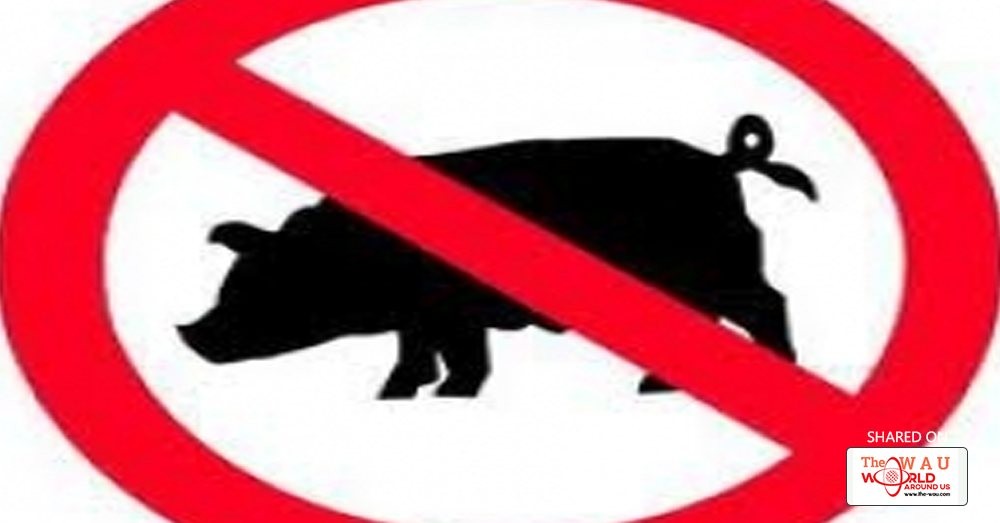The fact that consumption of pork is prohibited in Islam is well known. The following points explain various aspects of this prohibition:
1) A pig is a real garbage gut. It will eat anything including urine, excrement, dirt, decaying animal flesh, maggots, or decaying vegetables. They will even eat the cancerous growths off other pigs or animals.
2) The meat and fat of a pig absorbs toxins like a sponge. Their meat can be 30 times more toxic than beef or venison.
3) When eating beef or venison, it takes 8 to 9 hours to digest the meat so what little toxins are in the meat are slowly put into our system and can be filtered by the liver. But when pork is eaten, it takes only 4 hours to digest the meat. We thus get a much higher level of toxins within a shorter time.
4) Unlike other mammals, a pig does not sweat or perspire. Perspiration is a means by which toxins are removed from the body. Since a pig does not sweat, the toxins remain within its body and in the meat.
5) Pigs and swine are so poisonous that you can hardly kill them with strychnine or other poisons.
6) Farmers will often pen up pigs within a rattlesnake nest because the pigs will eat the snakes, and if bitten they will not be harmed by the venom.
7) When a pig is butchered, worms and insects take to its flesh sooner and faster than to other animal's flesh. In a few days the swine flesh is full of worms.
8) Swine and pigs have over a dozen parasites within them, such as tapeworms, flukes, worms, and trichinae. There is no safe temperature at which pork can be cooked to ensure that all these parasites, their cysts, and eggs will be killed.
9) Pig meat has twice as much fat as beef. A 3 oz T bone steak contains 8.5 grams of fat; a 3 oz pork chop contains 18 grams of fat. A 3 oz beef rib has 11.1 grams of fat; a 3 oz pork spare rib has 23.2 grams of fat.
10) Cows have a complex digestive system, having four stomachs. It thus takes over 24 hours to digest their vegetarian diet causing its food to be purified of toxins. In contrast, the swine's one stomach takes only about 4 hours to digest its foul diet, turning its toxic food into flesh.
11) The swine carries about 30 diseases which can be easily passed to humans. This is why God commanded that we are not even to touch their carcase (Leviticus 11:8).
12) The trichinae worm of the swine is microscopically small, and once ingested can lodge itself in our intestines, muscles, spinal cord or the brain. This results in the disease trichinosis. The symptoms are sometimes lacking, but when present they are mistaken for other diseases, such as typhoid, arthritis, rheumatism, gastritis, MS, meningitis, gall bladder trouble, or acute alcoholism.
13) The pig is so poisonous and filthy, that nature had to prepare him a sewer line or canal running down each leg with an outlet in the bottom of the foot. Out of this hole oozes pus and filth his body cannot pass into its system fast enough. Some of this pus gets into the meat of the pig.
14) According to Jewish law, pork is one of a number of foods forbidden from consumption by Jews. These foods are known as "non-kosher" foods. In order for a meat to be kosher, it must first come from a kosher animal. A kosher animal must be a ruminant and have split hooves - therefore cows, sheep, goats and deer are all kosher, whereas camels and pigs (having each only one sign of kashrut) are not kosher.
15) Quran, Holy book of Muslims also prohibits consumption of pork.
"He has made unlawful for you that which dies of itself and blood and the flesh of swine and that on which the name of any other than Allah has been invoked. But he who is driven by necessity, being neither disobedient nor exceeding the limit, then surely, Allah is Most Forgiving, Merciful." Quran 2:173
I cannot understand why anyone would eat it. You might as well vacuum all day and then take the vacuum bag and make a nice soup out of it.
" Of course our Creator has given us the health laws through the Holy Quran and not eating pigs is even CLEARLY mentioned in the Bible (Leviticus 11:07)
But some humans think they are more intelligent than the Creator so they choose.
The fact that consumption of pork is prohibited in Islam is well known. The following points explain various aspects of this prohibition:
Eating Pork is forbidden in the Quran
The Quran prohibits the consumption of pork in many verses including: 2:173, 5:3, 6:145 and 16:115.
"He has only forbidden to you dead animals, blood, the flesh of swine, and that which has been dedicated to other than Allah". (Al Baqara 2:173)
"Prohibited to you are dead animals, blood, the flesh of swine, and that which has been dedicated to other than Allah , and [those animals] killed by strangling or by a violent blow or by a head-long fall or by the goring of horns, and those from which a wild animal has eaten, except what you [are able to] slaughter [before its death], and those which are sacrificed on stone altars, and [prohibited is] that you seek decision through divining arrows. That is grave disobedience". (Al-Mā'idah 5:3)
Say, "I do not find within that which was revealed to me [anything] forbidden to one who would eat it unless it be a dead animal or blood spilled out or the flesh of swine - for indeed, it is impure - or it be [that slaughtered in] disobedience, dedicated to other than Allah" (Al-'An`ām 6:145).
"He has only forbidden to you dead animals, blood, the flesh of swine, and that which has been dedicated to other than Allah". (An-Naĥl 16:115)
The above verses of the Holy Quran are sufficient to satisfy Muslims as to why pork is forbidden and that any prohibition in the holy book is ultimately for their own good.
Further, Pigs have NO neck that makes it impossible to be slaughtered the Islamic way (The Halaal way) by the insertion of a knife in the neck and thus getting rid of the blood, which contains an abundance of uric acid, a toxic chemical substance that can be injurious to human health.
Disease caused by eating pork
Medical terms are excluded for easy understanding.
The pig, the worms and the pig-eater!
Eating the meat of pig can cause over SEVENTY different types of latent diseases as their body contains many TOXINS and deadly parasitic WORMS like tapeworm, roundworm, pinworm, hookworm, etc. If you eat pork you are likely to inject many of these worms or their eggs into your body! Most dangerous among them is the Tapeworm.
These worms can enter the human body through the mouth, anus, nose, or skin, with most species attaching themselves to the intestinal tract. This is why you have to stay away from pig.
Once inside the body, these worms lay eggs and raise a family! The baby worms along with their parents stroll inside your body and can reach any organ easily.
If they enter the brain it can cause memory loss. If they enter the heart it can cause heart attack, if they enter the eyes, it can cause blindness, and if they enter the liver, it can cause liver damage. Simply put, it can damage almost all the organs of the body.
One in six people in the US and Canada has trichinosis from eating trichina worms (roundworms), which are found in pork.
These worms are found in the flesh of pig and the diseases caused by eating pork are incurable once it reaches beyond a certain stage.
Influenza virus
Influenza or flu is one of the most lethal illnesses that pigs share with humans. This illness is harboured in the lungs of pigs during summer and tends to effect pigs and humans in the cooler months.
Influenza virus is common throughout pig populations worldwide. People with regular exposure to pigs are at increased risk of flu infection and other several fatal diseases.
Pork sausage contains bits of pig's lungs, so those who eat pork sausage tend to suffer more during the epidemics of influenza.
Pork has fat building material
Pork has very little muscle building material and contains excess of fat. This fat gets deposited in the vessels and can cause hypertension and heart attack. America is home to the most obese people in the world!
Those who consume pork are more prone to obesity because of the high fat content in pork. In this group, blood cholesterol level is frequently higher than normal; pork-eaters are more susceptible to arteriosclerosis, which may result in cardiovascular diseases, malfunction of the brain blood-circulation, vascular pathology of the lower limbs, etc.
Eating pork also leads to GALLSTONES.
Apart from the above mentioned, there are a host of other noxious diseases caused by eating pork. Most of the time it claims life.
What do pigs eat?
The pig is one of the filthiest animals on earth. It lives and thrives on muck, faces (shit or poop) or excreta and dirt. Often trash is collected and fed to pigs.
Pigs will scavenge and eat any kind of food, including dead insects, worms, tree bark, rotting carcasses, garbage, small animals and even other pigs. Surprisingly, pigs eat their own babies! They eat anything and everything.
Even if pigs are bred in clean and hygienic conditions they are kept together in farms or barns and they simply cannot resist eating filthy substances or shit from other pigs and of theirs own. They are just filthy by nature.
Another interesting fact is that the pig excretes only 2% of its total uric acid content; the remaining 98% remains an integral part of the body.
Read The Labels
The law requires that food manufacturers provide ingredient information on the food labels. That makes our job easier. All we need is to read the labels carefully. To be sure, ingredient labels are not the most readable part of many food packages, and they may not always contain sufficient information to determine the Halal status of a product. But reading food ingredient labels is the first essential step in that direction. As you read the labels, especially look for the following ingredients. They deserve a hard look:
Bakery and Cereal Products
Look for these in all bakery and cereal products: Gelatin, mono- and di-glycerides, animal shortening, whey. In cereals look for marshmallows. (They contain gelatin)
Fruits and Vegetables
Additives and preservatives may be added in the preparation of processed and canned fruits and vegetables. Look for: Gelatin, mono- and di-glyceride, cheeses, alcohol or wine.
Candies
Look for: Animal fat, gelatin, alcohol, whey, glycerol, glycerine, and marshmallows.
Meet The Suspects
Now that we have learned how to spot the suspect ingredients on a food label, here is more information that will help us decide whether these ingredients can be considered Halal or non-Halal.
Lard
Lard is a saturated fat obtained from swine (pigs), particularly from the abdominal cavity of the animal. Any food containing lard is completely Haram.
Mono- and di-glycerides
Mono-glyceride and di-glyceride are lipid (fat) molecules used as emulsifiers in shortening, bakery, and dairy products. These may be manufactured from vegetable oils, beef fat, lard, or marine oils. Therefore, Muslims should stick to labels saying vegetable or marine mono- and di-glvcerides.
Shortening
Shortening is a blend of fat and/or oil. If the label simply says 'shortening', stay away from it; it may even be lard. When the label says 'vegetable shortening' without listing all the vegetable sources or adding, the words "pure" or "100%". Even 1% lard will make it 100% haram.
Enzymes
Enzymes are a protein substance found and formed in all living cells that bring about chemical reactions inside or outside of the body. Enzymes can be extracted from animal sources, calves and pigs. Vegetable enzymes are okay.
IMPORTANT: Prohibition of eating pork does not imply that pigs are evil. There is nothing in Islam that actually declares the animal to be evil, or anything of the sort. Not eating pork is a very simple means of showing our devotion to our Lord.
Why You Should Consider Not Eating Pork
There are many religions that specifically forbid the consumption of pork. The meat is considered “unclean” and non-kosher. Is there a reason for this? Is there more to this religious teaching that we should all be aware of?
It seems as though the religions that condemn pork consumption are on to something, in fact there are many scientific claims to back this up.
Pigs are scavengers by nature, which means that they will eat almost anything, including rotten food, feces, urine, carcasses and even cancerous growths. Unfortunately the digestive system of a pig is incapable of effectively removing these accumulated toxins from the body because a pig will digest its food entirely in about 4 hours. This is simply not long enough to remove the excess toxins that were ingested, these toxins are then stored directly in the fat cells and organs of the pig itself.
“Sweating like a pig” yet? Ironically enough, that statement isn’t true -pigs do not have sweat glands which means they are unable to remove excess toxins by sweating (like we do). So naturally this means that pork meat would be a much more toxic meat than others and when you consume it you would be taking in those toxins as well. With our current environments, we really don’t need to expose our bodies to even more toxins if we don’t have to.
According to an investigation by Consumer Reports, 69% of all raw pork samples tested (of about 200 samples) were contaminated with a dangerous bacteria known as Yersinia enteroclitica. This bacteria can cause fever, gastrointestinal illness, diarrhea, vomiting and cramps.
Ground pork was more likely to be contaminated than pork chops. This pork also tested positive for other contaminants including a controversial drug called ractopamine, which is banned China and Europe. Many of the bacteria that were found in the pork were actually resistant to multiple antibiotics, which makes treatment problematic and potentially lethal if you were to get sick.
According to the report:
“We found salmonella, staphylococcus aureus, or listeria monocytogenes, more common causes of foodborne illness, in 3 to 7 percent of samples. And 11 percent harbored enterococcus, which can indicate fecal contamination and can cause problems such as urinary tract-infections.”
Pigs are a host to a number of parasites, viruses and other organisms, many of which can be directly transmitted to humans, some include:
- Taenia solium -an intestinal parasite that can cause tissue infection and loss of appetite.
- Menangle virus –a virus that can cause fever, chills, rashes, headaches and sweating.
- Trichinella –A parasitic roundworm that can cause edema, myalgia, fever and malaise.
- Hepatitis E –A viral inflammation that can cause fatigue, nausea and jaundice. More severe cases can lead to liver fibrosis and cirrhosis.
The study does indicate that if you were to cook the pork properly you can reduce the risk of the these parasites affecting you, but there is no guaranteed temperature for safety when it comes to pork.
If you still choose to consume pork, follow the following guidelines to increase safety.
As issued by Consumer Reports:
- When cooking pork, use a meat thermometer to ensure that it reaches the proper internal temperature, which kills potentially harmful bacteria: at least 145° F for whole pork and 160° F for ground pork.
- Keep raw pork and its juices separate from other foods, especially those eaten raw, such as salad.
- Wash your hands thoroughly after handling raw meat.
- Choose pork and other meat products that were raised without drugs. One way to do that is to buy certified organic pork, from pigs raised without antibiotics or ractopamine.
- Look for a clear statement regarding antibiotic use. “No antibiotics used” claims with a USDA Process Verified shield are more reliable than those without verification. Labels such as “Animal Welfare Approved” and “Certified Humane” indicate the prudent use of antibiotics to treat illness.
- Watch out for misleading labels. “Natural” has nothing to do with antibiotic use or how an animal was raised. We found unapproved claims, including “no antibiotic residues,” on packages of Sprouts pork sold in California and Arizona, and “no antibiotic growth promotants” on Farmland brand pork sold in several states. We reported those to the USDA in June 2012, and the agency told us it’s working with those companies to take “appropriate actions.” When we checked in early November, Sprouts had removed the claim from its packages.
What About Organic Pasture Raised Pork?
While this pork is obviously going to be much better for you to consume, it is very hard to find, and still poses certain health concerns. Pasture raised pork is very susceptible to Trichinella spiralis infection, also known as the “pork worm.” Trichinella is one of the most widespread parasites in the whole world, it has the potential to cause some very serious health concerns. Trichinella can be killed in the cooking process but one has to follow guidelines closely to make sure the meat is cooked through.
It is said that pork can be a “healthy” meat, but this entirely depends on how it was raised as well. Most, if not all of the pork most of us consume, is factory farmed. According to research by Dr Mercola: “So for most all industrially raised pork, I believe there is enough scientific evidence to justify the reservations or outright prohibitions in many cultures against consuming it. Nearly all pigs raised in the U.S. come from Concentrated Animal Feeding Operations, or CAFO’s. These inhumane environments are typically toxic breeding grounds for pathogens.
These animals spend their short, miserable lives on concrete and steel grates. Antibiotics are given liberally with their feed, making their massive waste even more toxic.
This is why you can smell a CAFO swine operation miles before you see it. At an operation like Joel Salatin’s, you couldn’t smell any sign of pigs. These pigs were raised humanely and organically, where both animal and land are managed symbiotically.
Unfortunately, raising animals in CAFO’s is the standard for Americans. For many of us, CAFO pork is the only option available.
Granted, the occasional consumption of pork might be fine, but it’s a risk, and the more you consume it the more likely it is that you will eventually acquire some type of infection.”
If The Pressing Health Concerns Aren’t Enough…
It’s a sad fact that 97 percent of all pigs in the United States today are raised in factory farms. This means that these pigs will never get to run on grass, breathe fresh air, or play in the sun. They are cramped and crowded into huge warehouses and fed a diet largely consisting of drugs and antibiotics to keep them alive and to encourage rapid growth.
Many people believe that pigs are highly intelligent creatures. Some say they are smarter than dogs, and others say they are smarter than your average 3 year old. Pigs can form complex social networks and they also have excellent memories.
If pigs were given the sufficient space that they need, they wouldn’t be soiling the areas where they sleep and eat, but in the factory farms the pigs have no choice but to live in their own feces, urine and vomit. Because of this, many (about 1/4) of pigs suffer from mange, an extremely itchy painful rash that doesn’t go away.
Sadly, because of the conditions the pigs are forced to live in they are inhaling toxic gas such as ammonia that comes from the urine and feces, this gas irritates the animals lungs to the point where over 80% of the pigs raised in the U.S. have pneumonia at the time of slaughter.
The horrors that these creatures have to endure on factory farms goes on and on, what was mentioned here is just the tip of what is actually going on behind closed doors.
Share This Post















